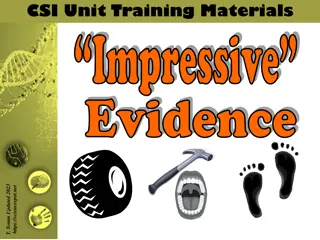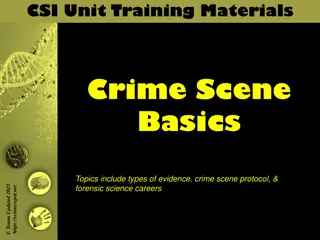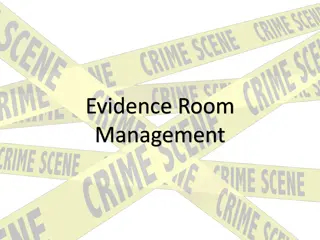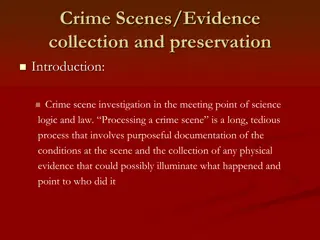Importance of Evidence in Crime Scene Investigations
Understanding the significance of each piece of evidence at a crime scene is crucial for a thorough investigation. Missing even one part can impact the entire process, highlighting the need for all pieces to be in place to grasp the full picture. By considering the Mechanism, Acute or chronic nature, Previous history, Pain details, and Sounds related to an injury, investigators can establish a comprehensive history using the MAPPS pneumonic. Sample questions help delve into how injuries occurred and their effects, fostering a deeper understanding of forensic processes.
Download Presentation

Please find below an Image/Link to download the presentation.
The content on the website is provided AS IS for your information and personal use only. It may not be sold, licensed, or shared on other websites without obtaining consent from the author.If you encounter any issues during the download, it is possible that the publisher has removed the file from their server.
You are allowed to download the files provided on this website for personal or commercial use, subject to the condition that they are used lawfully. All files are the property of their respective owners.
The content on the website is provided AS IS for your information and personal use only. It may not be sold, licensed, or shared on other websites without obtaining consent from the author.
E N D
Presentation Transcript
How many have taken a forensics class? Or does anyone have any interest in forensics? How many enjoy crime shows?
Think about the importance of each piece of evidence at a crime scene and share the answers to the following questions with a partner: 1. What would happen if one part of the investigation was left out? 2. Why is it important to have all of the pieces in order to see the whole picture? After discussing the answers with your partner, be prepared to share with the rest of the class.
HOPS Not all evidence is intriguing to study
Etiology The cause of an injury or a disease
Pathology the changes that occur as a result of an injury
Mechanism How the injury occurred
Acute An injury with a sudden occurrence
Chronic A recurring injury; one that has been going on for an extended period of time
To establish the history, use the MAPPS pneumonic: M = Mechanism of injury A = Acute or chronic P = Previous history of injury P = Pain (type & location) S = Sounds heard or felt at the time of injury or since
Sample questions: How did the injury occur? What caused the injury? What happened? Were you able to continue participating? Can you think of any other questions you might ask?
Acute or Chronic Sample Questions: When did the injury happen? Has the injury been going on for a while? If so, for how long? Can you think of any other questions you might ask?
Sample Questions: Has this ever happened before? If so, when did it happen? What was done to care for the injury? Can you think of any other questions you might ask?
Sample Questions: Where was the pain initially? Where does it hurt now? What relieves the pain? What makes the pain worse?
Sample Questions: Describe the pain. On a scale of 1 to 10, how severe is the pain? What have you done to relieve the pain? Can you think of any other questions you might ask?
Sample Questions: What did you hear? What did you feel? Can you think of any other questions you might ask?
Compare the uninvolved side with the involved side
Look for: Swelling Deformity / dislocation Discoloration Bleeding Break(s) in the skin
Compare the uninvolved side with the involved side Look for: Scars from previous surgeries Muscle atrophy (decreased size) Loss of movement
Look for: Is the athlete limping? Did the athlete need assistance to get up? Is the athlete protecting the injured extremity?
Get into a group of two. Based on what we know about injuries so far, choose one to mimic & answer some questions about. Alternate turns being the evaluator & the patient. Ask & answer at least FIVE different questions about an injury & make at least THREE observations EACH.























